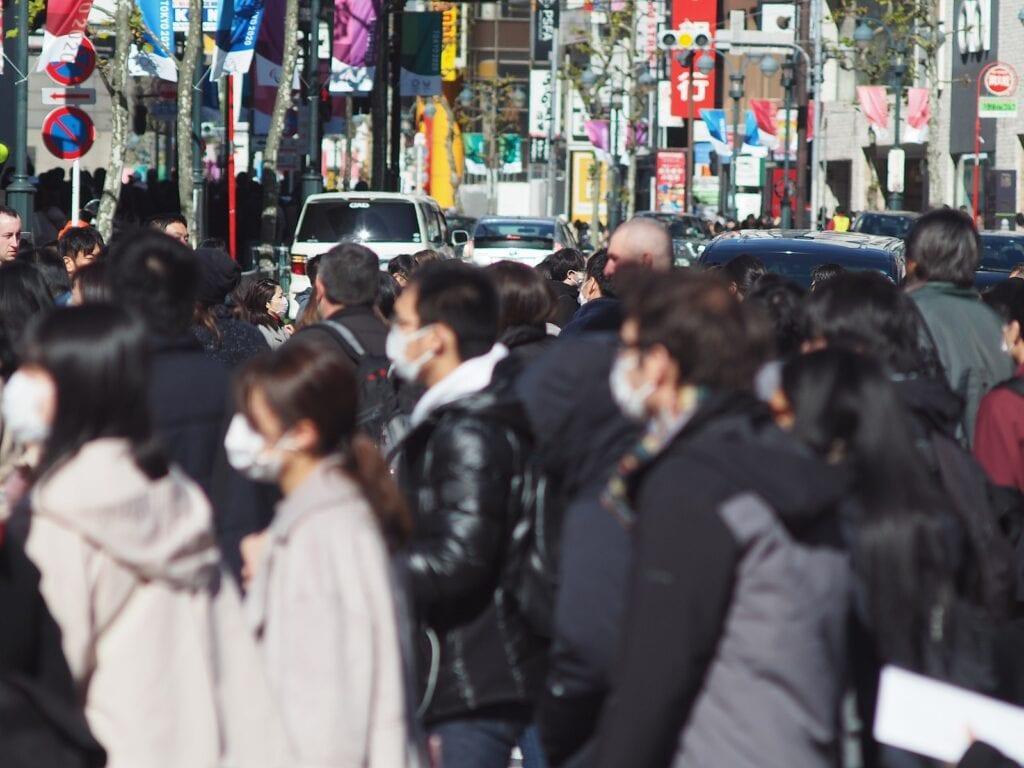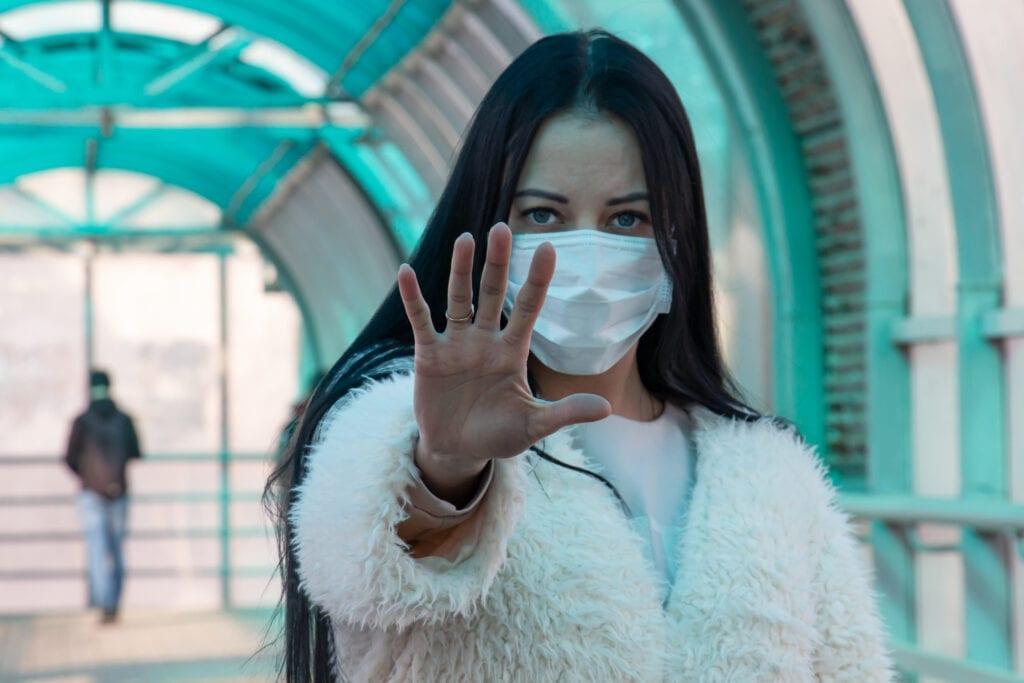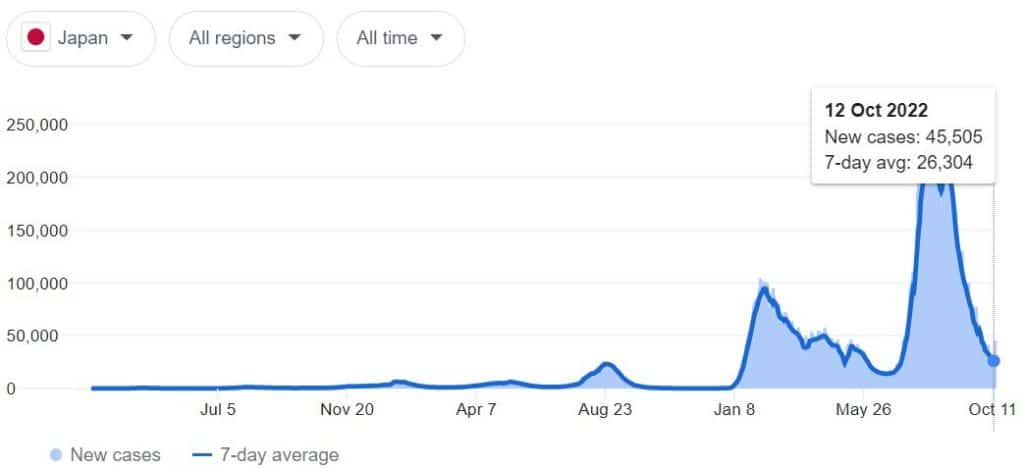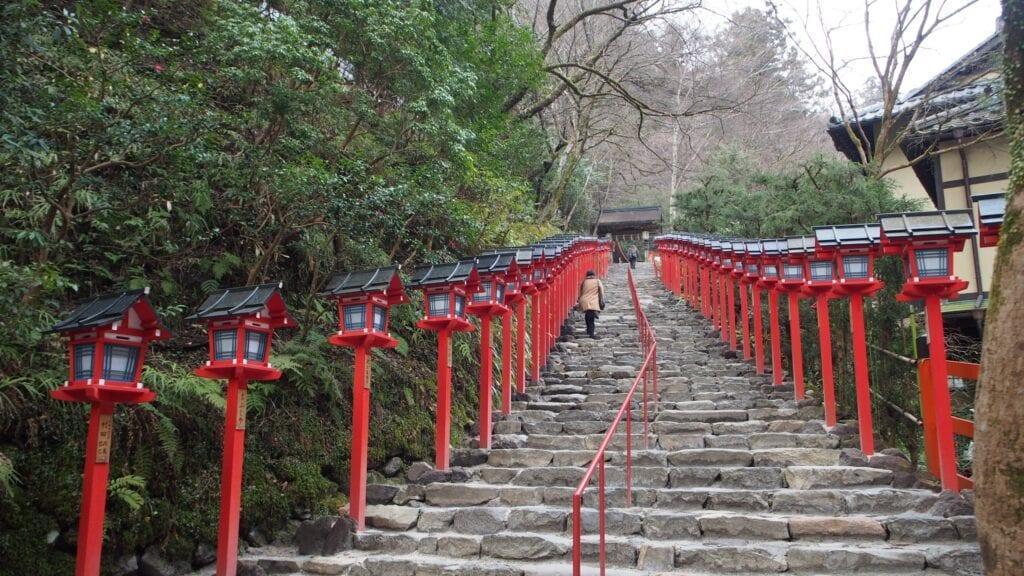Traveling toJapan became easier on October 11, but travelers are required to show proof of triple vaccination or a negative COVID -19 test result
Join our Travel Advice & Support FB Group
Japan Opening Tourism – Latest Updates

November 2 – International travelers to Japan exceeded 200,000 in September
Slowly but surely, foreign visitors are returning to Japan. According to the Japan National Tourism Organization, 206,500 foreign tourists visited the nation in September.
The number has never exceeded 200,000 since the pandemic began. South Korea had the most visitors with 32,700, followed by Vietnam (30,900), the United States (18,000) and China (17,600).
Since March, the government has gradually relaxed border controls, resulting in a sharp increase in foreign tourists compared to 2021, when Japan’s borders were virtually sealed. Compared to September last year, the number of tourists has increased by more than 11 times.
October 13 – Japan reopens its borders, but hotels are understaffed and stores closed
Compared to a record 31.8 million tourists in 2019, only slightly more than 500,000 people have visited Japan so far in 2022.
The government’s goal, Prime Minister Fumio Kishida said, is to generate 5 trillion yen (34.5 billion euros) in annual spending on tourists. But for a sector that has shrunk because of the pandemic, that goal may be too lofty.
Maria Satherley, a 70-year-old New Zealander, describes the Terminal 1 departure area as “like half a ghost town”
Most of the 260 stores and restaurants at Narita Airport, Japan’s largest international airport located about 70 kilometers from Tokyo, are closed.
September 29 – Japan to allow international tourists on Oct. 11
Japanese Prime Minister Fumio Kishida stated that independent travelers will be welcomed back to Japan on Oct. 11. The daily cap on the number of tourists arriving will also be lifted on that day.
Travelers from around the world will be able to enter Japan with proof of triple vaccination or a negative COVID -19 test result. The country will not require a visa for short-term visitors from qualified countries, including the United States.
“I hope many people will utilize them,” Kishida said at a news conference. “I want to support the travel, entertainment, and other industries that have been struggling during the coronavirus pandemic.”
Related: U.S. Airlines Respond Rapidly To Japan’s Reopening
How safe is Japan at the moment?

The CDC has recently placed Japan at Level 3 risk (High Level of COVID-19 in Japan).
Who can visit Japan?
Individual tourists from multiple countries.

COVID-19 situation in Japan

As of October 13, Japan has seen 21,656,190 cases of COVID-19, and 45,693 people have lost their lives to the virus.
What to do in Japan during pandemic

Domestic travel has been largely unimpeded in the country ensuring that Japanese citizens continue visiting their own tourism sites.
This means that many attractions have begun to reopen for tours.
This includes a wide array of Japan’s most popular sites, including the Tokyo Tower, Imperial East Gardens, Tokyo Disneyland, Tokyo National Museum, and more.
Below is a list of the most popular tourist attractions open in Tokyo and their current state of business.
Tokyo Tower (reopened)Tokyo Government Building observation decks (closed indefinitely)Kyu Shiba Rikyu (reopened)Tokyo Disneyland (reopened)Tokyo DisneySea (reopened)Guided tours of the Imperial Palace (reopened)Imperial East Gardens (reopened)Hama Rikyu (reopened)Rikugien (reopened)Edo Open Air Museum (reopened)Shinjuku Gyoen (reopened)Koishikawa Korakuen (reopened)Kiyosumi Garden (reopened)Showa Memorial Park (reopened)Ghibli Museum (reopened)Institute for Nature Study (reopened)Sumida Hokusai Museum (reopened)Tokyo National Museum (reopened)Tokyo Skytree (reopened)Sumida Aquarium (reopened)Edo-Tokyo Museum (reopened)
Source
Disclaimer: Travel restrictions and governmental regulations can change rapidly and the information below might be outdated within a few hours. Therefore, double-check all information with your embassy or on official websites. Traveling Lifestyle does not take any responsibility for your decision to travel.
Japan reopening for tourism: Updates Archives
September 19 – Japan could drop entry restrictions by October
Japan intends to remove most of the Covid-related restrictions on foreign tourists, including eliminating visa requirements and allowing individual tourism before the fall travel season, according to local station FNN.
The broadcaster, which did not specify where the information came from, said these restrictions will be eased for travelers who have been vaccinated three times or have a negative Covid test.
Earlier, Nikkei Asia reported that visa requirements, which deter many leisure travelers, could remain in place. Officials are arguing over whether the restrictions should be lifted all at once or gradually.
One of the latest updates suggests that Japan could drop all restrictions by October.
September 9 – Japan allows non-escorted visitors on package tours as of Sept. 7
Prime Minister Fumio Kishida announced last week that Japan will allow unescorted visitors on package tours and increase the daily arrival cap to 50,000 beginning Sept. 7.
“In countries worldwide, international exchange is growing. To participate in these exchanges and to benefit from the weaker yen, we will raise the daily arrival cap to 50,000 from Sept. 7, as well as allow (tourists on) nonguided tours from all countries to enter the country,” Kishida said.
The prime minister also stated that he will explore further easing restrictions based on various conditions at home and abroad, with the goal of bringing border controls in line with other members of the Group of Seven major countries.
ugust 26 – Japan might scrap the Covid testing entry requirement in September
The Japanese government announced this week plans to ease some of the travel restrictions. In September, they will double the daily tourist limit, and also scrapping the testing requirements required for entry is on the table. This would mean traveling to Japan would be almost back to normal.
ugust – Japan continues to slowly ease its entry restrictions
The Japanese government is increasingly easing these restrictions and allowing a greater number of foreign nationals to enter the country through various visa pathways. Although significant restrictions remain in place, foreign nationals seeking to enter Japan now have more opportunities to do so than at any time in the past two years.
Just last month, Japan reduced the isolation period for close contacts of COVID-19 cases from seven to five days. A negative test even allows only three days of quarantine, but test kits are hard to come by.
The country still allows only 20,000 people per day to enter the country and requires proof of a negative test result within the past 72 hours, a provision that the U.S., U.K., and Germany have eliminated.
June 30 – Japan only received 1,500 tourists since it reopened for “tourism” on June 10
Only about 1,500 foreign visitors entered Japan in the month since it reopened to tourists on June 10, according to the Immigration Services Agency of Japan.
The agency and the Japan Tourism Agency explain the low number by the lengthy procedures involved in visiting Japan.
Tourists must produce proof of a negative PCR test and get a sightseeing visa. In addition, they are limited to taking group trips, which are not as popular with Western tourists.
To make matters worse, Japan currently has the highest number of COVID instances reported on a daily basis of any country, a questionable distinction that is dashing hopes the government may reduce its rigorous border controls.
With 196,000 new cases nationwide reported on Tuesday, Japan surpassed both the United States and Germany and reached the second-highest level ever.
July – Covid-19 cases on the rise in Japan after the country lifted restrictions
Local authorities have their hands full trying to keep up with the rapidly growing number of coronavirus patients.
Since the government is not curtailing activities, it now faces the double dilemma of preventing an overload of the medical system while trying to keep society running as usual.
“If the number of seriously ill patients increases, it is possible that hospital beds will become occupied for a long period of time,” said Hironori Sagara, director of Showa University Hospital in Tokyo.
On Saturday, the number of new infections reached a record high of more than 110,000 across the country due to the spread of the highly transmissible BA.5 omicron subvariant.
June – Japan reopens to groups of tourists from 98 nations
Japan opened its borders to foreign tourists on Friday and is beginning to accept applications, but only for those on guided package tours who are willing to wear masks and follow other antivirus measures, as the country tries to balance business and infection concerns.
“Active exchanges between people are the foundation of the economy and society,” said Prime Minister Fumio Kishida while delivering a speech at the Future of Asia conference in Tokyo. “From the 10th of next month, we will restart the admission of tourists on guided package tours.”
According to the Japan Tourism Agency, tours are approved from 98 countries and territories with low infection concerns, including the United States, the United Kingdom, China, South Korea, Thailand, and Singapore.
May 18 – Japan is Reopening for Tourism to 4 Countries on May-end
On Tuesday, May 17, government officials announced that Japan will accept some tourists from the U.S., Australia, Thailand, and Singapore on a trial basis starting at the end of this month.
According to the Ministry of Land, Infrastructure, Transport, and Tourism, these travelers will be allowed into Japan provided they all have booster shots and are part of a government-approved tour group with a fixed itinerary.
The trial will allow the government to learn how to respond if (when) a positive case is discovered in the event the borders are fully opened.
However, according to Kyodo News, the government plans to massively welcome tourists in June.
May 2- Government should normalize its entry bans ASAP, say panel members
Masakazu Tokura, chairman of Keidanren, Japan’s largest business lobby, said authorities should “gradually resume” allowing travelers to enter the country to combat the country’s shrinking of the income which is largely due to a decline in travelers
He and other four private sector members also suggested that the government should specify the criteria for additional relaxation in order to help potential tourists plan their return.
After the meeting, Daishiro Yamagiwa, the minister in charge of the government’s COVID-19 response, said that “the government agrees with the private-sector members on the direction we should go toward eventually opening the border to tourists.”
“But the timeline of easing the regulations should be decided appropriately,” he said, adding that the course of the coronavirus pandemic remains unpredictable.
pril 18 – Japan lowers entry restrictions for 106 countries
Japan eased its entry ban on 106 countries, including the United Kingdom, the United States, Canada, and France, on April 8, after two years of strict border controls.
In addition, up to 10,000 arrivals are now allowed per day provided that they are triple vaccinated and have a negative pre-departure Covid-19 test.
The new regulation only applies to business travelers, foreign students and researchers.
Read our full post: Japan To Lift Travel Restrictions On 106 Countries Including The U.S. From April 8
pril 4 – Japan raises its entry cap to 10,000 people per day from April 10
Japan will allow in 10,000 non-tourist visitors per day starting April 10, up from the current 7,000, the top government spokesman said Friday.
In recent weeks, the government has begun to ease its “most stringent” border controls among the Group of Seven nations, according to Prime Minister Fumio Kisida.
“Japan plans to increase international movements of people in stages by taking into account the infection situation at home and abroad and border control measures that other major nations have taken,” Chief Cabinet Secretary Hirokazu Matsuno said at a press briefing.
March 22 – Japan Removes Covid-19 restrictions on Bars and Restaurants
The Japanese government lifted coronavirus restrictions on bars and restaurants across the country on Monday, ending what had been referred to as “officially voluntary” limits on business hours.
It also lifted its “quasi-state of emergency” in 18 prefectures, including Tokyo and Osaka, on Tuesday, citing a drop in new infections.
It is the first time since January that Japan has no emergency measures in place.
The daily average of new coronavirus cases in Japan is reportedly falling after peaking at almost 100,000 last month.
March 5 – Japan to rise daily arrival cap to 7,000 March 14
Starting March 14, Japan will increase the daily limit for international visitors to 7,000 people and extend quasi-emergencies in 18 of the country’s 31 prefectures, according to Prime Minister Fumio Kishida.
Businesses and universities have complained that the existing cap is unsustainable, given that there are an estimated 400,000 foreign nationals waiting to enter the island.
According to Kyodo News, when corporate travel is not in demand, this travel scheme will give students entry priority.
“We will take further measures to rejuvenate social and economic activities if we can more clearly see an exit of the sixth wave in the future,” Kishida told reporters.
February 18 – Japan to allow international students and business people back in from March.
Beginning in March, the Japanese government will allow a “limited number” of international students and business people to enter the country, said Primer Minister.
The decision was made in response to pressure from the business and academic sectors, as well as a drop in Omicron cases in 36 prefectures.
When reviewing border policy, the government took into account “the situation in other countries.” “However, loosening [the rules] all at once is not realistic,” he added.
The PM did not provide further details about entry requirements.
February 7 – Business leaders urged Japan to reopen borders
Unlike other Asian economies that have closed their borders owing to a zero-COVID-19 policy, Japan is reporting over 100,000 daily cases, making the border closure incomprehensible to most travelers and business people.
More than 100 top Japanese academics penned a public letter urging Prime Minister Fumio Kishida to allow at least international students to enter the country under strict health restrictions.
Business leaders in Japan have begun to lobby the government to loosen restrictions. Keidanren, the head of Japan’s powerful business lobby, has warned that businesses can no longer rely on just domestic consumers.
Analysts believe that by keeping borders close Japan risks alienating allies. But the government remains silent in the face of such claims.
January 27 – More than 33,000 people have signed a petition for Japan to reopen its borders
Over 100 academics and international relations professionals signed a letter to Japan’s Prime Minister last week urging him to reopen the country to foreign arrivals.
According to researchers, local labs have been struggling due to a shortage of overseas students and workers.
People who have been denied entry have protested outside Japanese embassies. An online petition advocating for the admission of students and employees has received more than 33,000 signatures.
The government said last week that it would make an exemption for students, but just 87 state-sponsored students were permitted to enter.
Japan has yet to announce whether it will extend the border restrictions that are set to expire at the end of February.
January 12 – Japan has extended its travel ban on all countries until the end of February.
Japan has extended its travel ban on almost all new foreign arrivals until February-end and reopened mass-vaccination centers as it battles a spike of cases, announced the government Tuesday.
“The infection situations regarding Omicron are clearly different at home from abroad, so the framework (of the current border controls) will be maintained until the end of February,” Kishida told reporters.
The government would consider some exemptions for foreign family members of Japanese people as well as people studying in Japan but it has not been confirmed yet.
Read our full post: Japan Extends Entry Ban On Foreign Travelers Until February
December 19 – Japan to extend the ban on all countries until early next year
The government banned all foreign nationals from entering the country on Nov. 30. It also imposed tighter quarantine restrictions on anyone returning from countries where the Omicron variant had been confirmed.
The restrictions were supposed to be in place for a month.
However, Japan’s Prime Minister has said that the government will extend the tightened border restrictions into early next year when they can collect more information about the new variant.
According to a Japanese official, maintaining the current border restrictions in place beyond next month is also an option.
December 4 – Japan has closed its borders to all international travelers
Japan announced it will suspend entry of all foreign visitors from all countries amid concerns over the new COVID-19 variant.
“This is a preventive, emergency measure to avoid a worst-case scenario,” said the Prime Minister. “This is an extraordinary measure for the time being just until we know more about the omicron variant.”
Returning Japanese travelers must undergo a 14-day mandatory quarantine regardless of their vaccine status.
Read our full post: Japan Closes Borders To All Foreigners Due to Omicron Variant
November 9 – Japan started reopening borders for some categories of travelers on Nov. 8
Japan started to reopen borders for business travelers, foreign students, and technical interns on Monday.
Entering Japan is still not easy. In addition to the country’s strict entry restrictions, companies that host or sponsor these travelers must commit to “meticulously managing their movements.”
It may turn into a titanic task given that Japan has already issued visas for over 370,000 of these newly allowed travelers, who are now waiting in line to enter the island.
The government has stated that this process will be carried out in stages. Despite the fact that this is a significant step forward in Japan’s reopening, the country will remain restricted to tourists for the time being.
October 28 – Tokyo and Osaka lifted some nightlife restrictions
Tokyo eased most restrictions on bar and restaurant opening hours on Oct. 25 after COVID-19 infection cases dropped dramatically, officials announced last week.
Osaka also lifted restrictions on the same date. Both prefectures asked restaurants and bars to limit the number of people who can sit together to four until Nov 30, which is a great step ahead.
Tokyo, a city of 14 million inhabitants, has been reported an average of only 47 cases per day over the last 7 days.
“Vaccination has been making great progress. We have seen cooperation with anti-infection measures. As a result, infections have been rapidly contained,” said Tokyo’s governor.
October 14 – Japan evaluates timing for resuming a popular subsidized travel scheme
The “Go To Travel” program started in July 2020 aiming to boost domestic travel, but it was temporarily suspended due to concerns regarding the spread of the coronavirus.
As the local COVID-19 restrictions ease, Japan looks to revive the popular travel program, said the newly appointed minister for land, infrastructure, transport, and tourism.
“It is important to balance the prevention of contagion and the promotion of tourism.”
The minister also revealed the country expects to receive 60 million inbound tourists by 2030.
October 4 – Japan eases restrictions for vaccinated inbound travelers
Japan’s Prime Minister has agreed to reduce the quarantine period from 14 to 10 days for visitors who can provide evidence of being fully immunized against the coronavirus with one of the approved vaccines.
Up to date, Japan has approved Pfizer, Moderna, and AstraZeneca vaccines. Travelers vaccinated with China’s Sinopharm and the United States’ Johnson & Johnson are considered unvaccinated.
The country also lifted a great number of local restrictions. Businesses are now allowed to serve alcohol and theme parks to increase capacity.
Read our full article: Japan Lifted State of Emergency But No Signs Of Tourism Reopening
September 12 – Japan would ease COVID-19 restrictions in November
The Japanese government plans to ease restrictions around November when Covid-19 drugs will be more accessible for the population.
Under the new scheme, businesses would be permitted to serve alcohol and remain open after 8:00 p.m.
Additionally, fully vaccinated people would be allowed inter-prefectural travel again.
For now, the State of emergency will be extended through Sept. 30 in Tokyo and nearby cities.
Source: Nippon TV News
ugust 14 – Japan to issue vaccine passports for outbound travel, but continues to be closed for inbound tourism.
Japan has started issuing vaccine passports for international travel. The plan is to streamline international travel for Japanese people but it does not mean that they will accept inbound travel yet.
To date, Japan has agreements with Italy, Austria, Sri Lanka, Slovakia, Saint Christopher and Nevis, Saint Vincent, Thailand (Phuket, Samui, Pha Ngan, Tao, only), Germany, Turkey, Papua New Guinea, Bulgaria, Belize, Poland, Hong Kong, Honduras, Lithuania and South Korea.
The country is struggling to be accepted by other nations because most countries are not willing to allow Japanese visitors without any reciprocity.
Source: NHK.org
ugust 28 – Japan expands state of emergency through Sept. 12 as Delta cases increase – No reopening in sight
Japanese officials have expanded its state of emergency to Aichi, Gifu, Hiroshima, Hokkaido, Mie, Miyagi, Okayama, and Shiga prefectures from Aug. 27 to Sept. 12 to fight the uncontrollable COVID-19 cases overwhelming the health system.
“Critical cases have spiked suddenly and the medical system is in an extremely dire state,” said Economy Minister Yasutoshi Nishimura at a panel of experts.
Some 90% of ICU beds are now occupied with coronavirus patients in Tokyo.
Considering these numbers, the government is reluctant to provide a border reopening date.
Source: Aljazeera
June 22 – Japan to launch travel vaccine passport in July
Japanese travelers will have access to a new vaccine passport from July, according to the government.
This paper-based certificate (not digital) is supposed to permit Japanese travelers to have easier access to other countries.
“We are preparing to issue a certificate of vaccination for those who need one… when they visit foreign countries,” Japan spokesman Katsunobu Kato said at a press conference.
The government also announced the ending of the state of emergency from June 20. Only Okinawa Prefecture will remain under the measure through July 11.
(Source: Nikkei Asia)
May 10 – Japan is reportedly working on Vaccine passports to reopen international borders
Japanese authorities are reportedly working on a vaccine passport app. This app will be connected to the Japan Vaccination Record System and the Ministry of Health, Labor and Welfare. It will keep record not only of travelers’ vaccination certificates but also of negative COVID-19 tests so unvaccinated travelers don’t feel discriminated against.
This means Japan is also working on a reopening plan to allow international visitors. So far, the country is open for essential travel only and this exception does not even include all countries.
Japanese Minister Taro Kono said that if other countries have already started using vaccine passports to reopen travel, “so Japan will have to consider it too.”
March 11
Japan has had to make a tough decision not only for the world but also for its own economy. The government has officially decided not to extend their invitations to this summer’s Tokyo Olympics and Paralympics Games to foreign visitors.
Officials say the country is obligated to protect the Japanese population from a bigger spread of the coronavirus and its new variants.
The Olympic Committee and two other organizations will be announcing this decision to the international community possibly next week.
The post Japan Is Open For Tourism And Had Over 200K Visitors In September appeared first on Traveling Lifestyle.
-----------------------------
By: Viktor Vincej
Title: Japan Is Open For Tourism And Had Over 200K Visitors In September
Sourced From: www.travelinglifestyle.net/japan-reopening-borders-with-restrictions/
Published Date: Tue, 10 Oct 2023 16:05:57 +0000
Read More
 Privacy PolicyTerms And Conditions
Privacy PolicyTerms And Conditions
